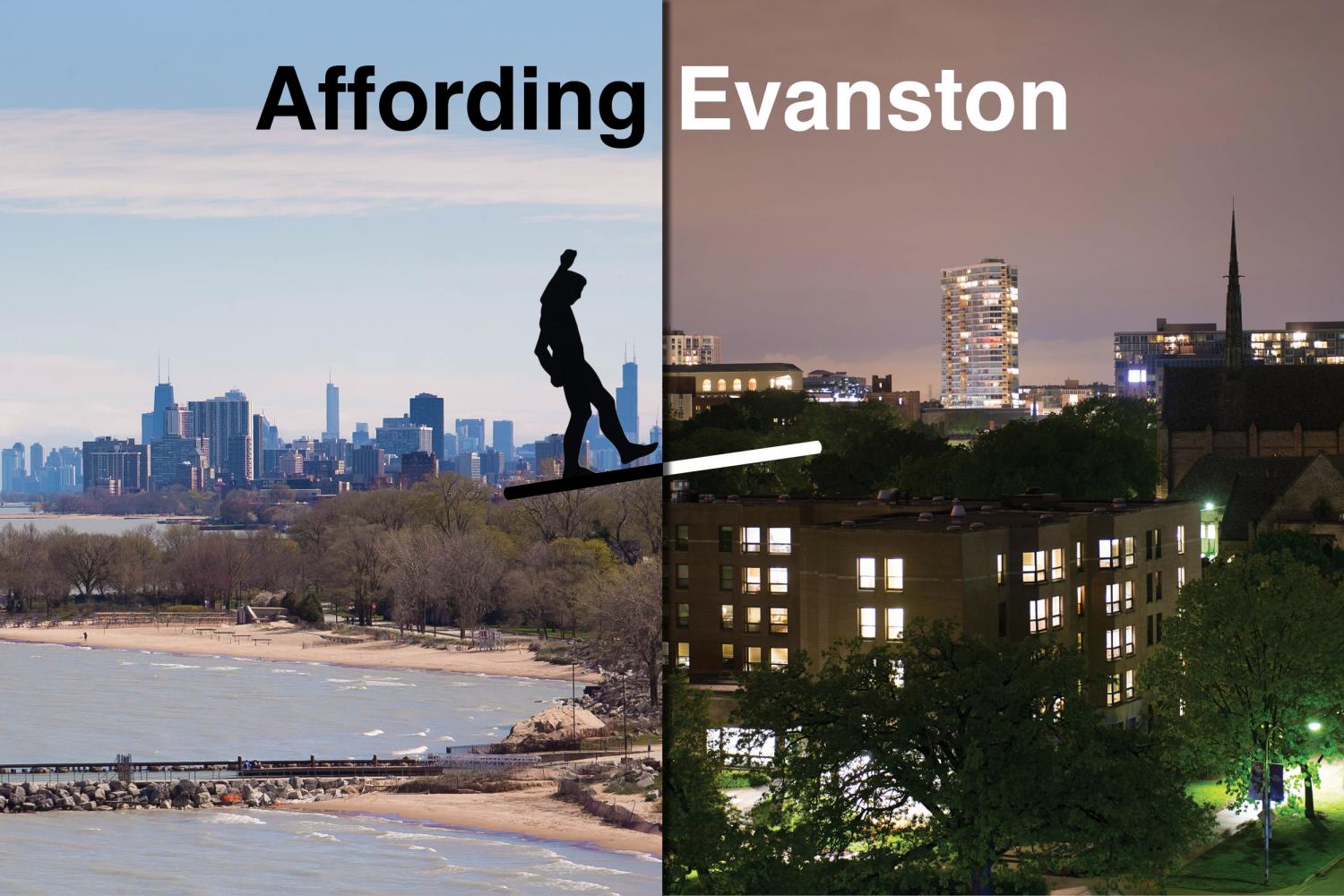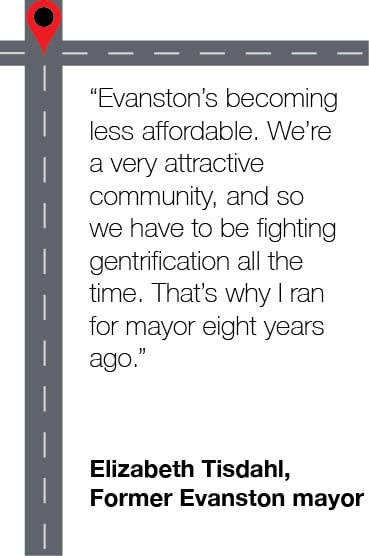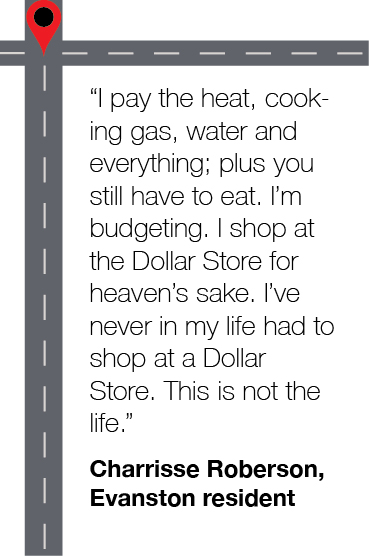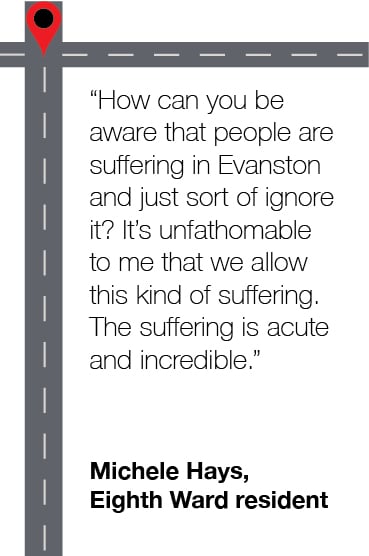In Focus: As cost of living in Evanston rises, some residents struggle to keep up
May 24, 2017
Charrisse Roberson did “everything right.” She never drank alcohol or used drugs. She did odd jobs around the neighborhood as a child and went on to earn a bachelor’s degree. She even held management positions for most of her life.
Then, in 2008, things took a turn for the worse. While working as a branch manager at TCF Bank, Roberson collapsed. When she reached the hospital, doctors gave her a blood transfusion but no explanation for the sudden affliction. Gradually, the mysterious condition got worse and now Roberson needs a transfusion every week.
Because she can no longer work, the government awarded her disability benefits, which she uses to support her two dependents. Roberson also qualifies for Section 8 — a federal program that helps “very low-income families” afford housing. But Roberson, who started a boutique clothing line to make additional income, said that is not enough.
“I pay the heat, cooking gas, water and everything; plus you still have to eat,” she said. “I’m budgeting. I shop at the Dollar Store for heaven’s sake. I’ve never in my life had to shop at a Dollar Store. This is not the life.”
Roberson’s is one of more than 5,000 Evanston households that pay over 50 percent of their income to housing costs. At the same time, the city has lost 40 percent of its affordable housing units — for renters at 60 percent of the area median income and homebuyers at 80 percent — between 2004 and 2013 to high-priced rentals and homes.
And after an election cycle where many municipal candidates vowed to improve affordability, voters passed a referendum in April to fund Evanston/Skokie School District 65 that would increase property taxes by roughly $450 a year.
Local officials and community leaders say maintaining affordability should be a high priority, inextricably linked to the city’s diverse population and progressive values. Nevertheless, the problem is getting worse due in part to an exodus of unskilled jobs, lack of affordable housing and federal budget cuts.
“Evanston’s becoming less affordable,” former Mayor Elizabeth Tisdahl said. “We’re a very attractive community, and so we have to be fighting gentrification all the time. That’s why I ran for mayor eight years ago.”
Losing the ‘character of Evanston’
Numerous community members highlighted what they call the “character of Evanston,” a longstanding dedication to progressivism, equity and diversity.
“We’re a lovely community on the lake; we’ve got big trees, some great architecture,” Tisdahl said. “But what makes us different than Kenilworth or Wilmette or Lake Forest is our … diverse cultures and diverse viewpoints.”
Evanston has the largest percentage of black and Hispanic or Latino residents of surrounding suburban communities. The city also has a low and moderate-income population that makes up roughly 34 percent of all residents.
Mayor Steve Hagerty, who moved to Evanston in 1999, said he values the city’s diversity because of its ability to build empathy. Those living in uniform communities, he said, risk forming an opinion of others without any solid basis.
“Diversity brings an understanding of people that are different than you,” he said. “There’s real value in that, particularly today when I think, certainly at a national level … there tends to be less empathy.”
Hagerty said while he recognized the importance of diversity, he was not certain if the city has become less affordable.
Fourth Ward resident Blair Garber, however, said he has no doubt the city has become less affordable. From 2000 to 2011, increased housing costs for both rent and purchase outpaced income gains. And over the past 15 years, Garber said, his taxes have more than doubled — prompting him to formulate an “exit strategy” should he have to leave.
“There really isn’t a cure for that except for the government to tighten its belt,” said Garber, who is the local Republican committeeman. “If you think affordable housing is a problem, wait until all the houses on Sheridan Road are abandoned. Then you’ll see what a problem is.”
Garber said Evanston would be better off “letting the market handle it.”
But other residents disagree. Eamon Kelly, a 4th Ward resident and Evanston’s Democratic committeeman, said the community has an obligation to assist low-income families, some of whom have lived here for generations. He said some solutions could come in the form of tax relief, financial assistance or more affordable housing — all of which might help offset the “dramatic increase” in housing costs.
With rising costs, Kelly said, comes the risk of becoming more homogenous. Over the past 17 years, the black population in Evanston has dropped from more than 22 percent to roughly 17 percent. Still, Hispanic or Latino, and Asian communities have grown in that same time period.
“I certainly treasure the Evanston community and valued growing up in a diverse community,” Kelly said. “As we price out economic diversity — and to a certain extent racial and ethnic diversity — it threatens to change the character of our community.”
For some residents, however, the character of Evanston is already in flux.
Josh, who asked to remain anonymous due to a precarious housing situation, said he grew up in Evanston, went through District 65 schools and graduated from Evanston Township High School. An active student, Josh said he made a concerted effort to engage with the community through various activities: Relay For Life, Hillside Food Pantry, debate club. He even spoke on behalf of his peers at City Council and school board meetings.
After high school, Josh sought a higher education and received a certified nursing assistant designation from Kishwaukee College in Malta, Illinois. But when the Evanston native returned home to find a job, he said he hit a series of “brick walls.”
“When you grow up in a community that states, ‘We’re here for you, we’ll support you no matter what’ … and you find out that’s not so, it kind of makes you do a double take,” he said.
Living at the ‘Y’
After failing to find affordable housing through conventional methods, Josh said he will soon turn to a “last resort”: the McGaw YMCA.
The YMCA provides affordable housing for single men, said Pamela McKenzie, a senior residence director. The space, which has 172 single-occupancy rooms, operates much like a dormitory — complete with shared amenities and common gathering spaces.

McGaw YMCA, 1000 Grove St. Some residents have been forced to move into the YMCA after failing to find alternative housing.
McKenzie said the program does not rely on government funding due to the uncertainty of various grants. Instead, the YMCA shrinks down room sizes — which range from roughly 100 square feet to 170 square feet — to maximize renters and minimize costs; rooms rent from roughly $134 to $174 a week, or $47 a day.
For the first time in recent memory, McKenzie said the YMCA has a small waiting list for rooms. The building also averages between 95 and 97 percent occupancy rates, which McKenzie said is “ridiculous.”
“Everybody wants to live in a beautiful community where the city takes great care of the sidewalks and there’s all this public transit and you feel safe,” she said. “(YMCA) is a stepping stone for some and a home for others.”
McKenzie attributed the high demand for housing to a revival of the local job market and a declining supply of affordable units. The YMCA requires potential residents to net twice the cost of rent before moving in, so McKenzie said it did not see much demand during the Great Recession in 2008.
Now that more jobs are popping up, people have a steady wage with which to pay for housing. But the lack of affordable options pushes them to programs like the men’s residence at the YMCA, McKenzie said.
Though there is no target demographic for the program, McKenzie said most residents earn under $32,000 a year and are over the age of 50. In addition, she said, the majority come from either Evanston or the North Shore.
James, who asked to remain anonymous to protect his reputation, said he moved to the YMCA roughly six years ago after losing his consulting job in Chicago. The mid-60s-year-old said he was drawn to Evanston because of its diverse, “friendly” community and close proximity to public transportation.
While his current living situation is “comfortable,” James said he would like to find a place of his own. Now that he feels a part of the community, James said he wanted to stay in Evanston and felt confident about finding a suitable home.
But when James leaves the YMCA, he will be met with a dwindling supply of affordable housing units, many of which have been replaced by high-end properties. According to city documents, between 2000 and 2011, the number of low-priced units — those that rent for between $500 to $699 a month — fell by roughly 85 percent, while those that cost more than $1,000 per month rose by 66 percent.
In addition, the waiting list for public housing in Evanston stands at more than 1,800 people long and is closed to new applicants.
“One of the goals of Evanston is to maintain — and even increase — diversity, and I don’t think you can do that without increasing equity,” said Sue Loellbach, director of development at Connections for the Homeless. “I don’t think there’s any possible way of increasing that equity without having more affordable housing.”
Dempster Street pushback
In the 2nd Ward, a Chicago-based organization has met sharp objection from some residents over a new affordable housing project.
The proposed building would take over a roughly 20,000-square-foot lot off Dempster Street and include 16 units of affordable housing. Britt Shawver, CEO of Housing Opportunities for Women, said she had fielded “numerous” requests for more affordable housing in Evanston over the past decade.
“We are frequently able to help families, but we are not frequently able to help them stay in Evanston because the housing costs are so prohibitive,” Shawver said.
With the roughly $5 million project off Dempster Street, Shawver said she hoped to alleviate some of those issues and bring a “high value investment” to the community. Funding for the building would come from six different entities — including Evanston — which have not yet committed to the project, she added.
But a group of 2nd Ward residents have pushed back. Members of the group said they recognize the need for affordable housing in the city, but that this particular project would “destroy the neighborhood.”
Residents said the current single-family house, which sits on the corner of Pitner Avenue and Dempster Street, is zoned differently than the rest of the neighborhood — allowing for a three-story structure unlike any other in the area. Ray Freedman, who lives nearby, said he could not see any benefit to an affordable housing project like the one proposed.
“I’m not against affordable housing. … It’s just knocking down a single-family house and putting up 16 units in its place is ridiculous,” he said. “In this particular spot, it makes absolutely no sense at all. It would hurt everybody.”
Freedman and other residents said the area already sees a lot of traffic. In addition, other residents expressed concern about damage to their property that could come from construction.

1305 Pitner Ave. A proposed affordable housing project would replace the single-family home with a three-story building.
Instead, residents have urged leaders to look for other solutions. The city in 2015 passed an ordinance to encourage development of more affordable housing. The measure, which went into effect last year, requires some new developments to include affordable units or for the developers to pay the city $75,000 to $100,000 per unit. The contributions then go into a fund to develop and rehabilitate affordable housing.
City manager Wally Bobkiewicz said developers have generally chosen to contribute to that fund — which currently has more than $1.4 million — and opt out of building affordable units. But due to the “extremely high” cost of building affordable housing, Bobkiewicz said their contributions have fallen short.
In the future, Bobkiewicz said, officials would have to mix finance and policy to ensure that Evanston’s “endangered” affordability does not disappear.
“The bottom line is people want to live here … and if we’re going to ensure affordability the market is not going to do that alone,” he said. “Government — city, county, state, federal — is going to have to help.”
Section 8 struggles
At least 560 Evanston residents receive aid in the form of Housing Choice Vouchers, which subsidize housing units in the private market. But due to federal budget cuts, county officials said they will have to decrease those subsidies and shrink the program.
And that’s assuming a voucher is even available: Housing Authority of Cook County communications director Monique Bond said the waiting list is roughly 13,000 people long and closed to new applicants.
“To be able to sustain our operation based on last year’s allocation (from the U.S. Department of Housing and Urban Development), we’re going to have to reduce those vouchers,” she said.
According to a draft budget obtained by Politico, President Donald Trump plans to cut roughly $6 billion from HUD’s budget for fiscal year 2018. The new budget could significantly impact programs that benefit low and moderate-income communities — like Housing Choice Vouchers.
The program — more commonly referred to as Section 8 vouchers — helps low-income families afford housing in the private market. After receiving a voucher, participants may choose any unit that fits the program’s standards.
Cook County Board Commissioner Larry Suffredin, who has lived in Evanston for 40 years, said the county has always been dedicated to making housing economically accessible. Suffredin said discrimination based on Section 8 status is illegal in Cook County. After a 10-year campaign — and multiple unsuccessful attempts to pass similar measures — the county voted in 2013 to classify voucher holders as a “protected class.”
Some residents, however, said they were turned away from units after alerting landlords to their voucher status. Roberson, for example, said she moved around for years before finally receiving a voucher in 2010. With the new voucher, she moved into a three-bedroom unit on the corner of Emerson Street and Dodge Avenue.
Roberson said the unit cost roughly $1,300 a month through the Section 8 voucher program, subject to a potential 5 percent increase each year. But when her lease ran out in February, Roberson said the landlord jacked up her rent to $1,800 and HUD would not pay the difference.
“Now I have to move, but guess what happens when you have to move and you’re low income?” she said. “You still have to come up with your first month, security deposit — plus you still have to pay the current landlord.”
Roberson said she has been looking for a new place to live, but the search cost — more than $500 — and the “stigma” about Section 8 holders has made it difficult.
“It has been branded in such a way where they believe somehow everybody who’s on it are bums … and these people are lazy and they just don’t want to work,” Roberson said. “I worked my whole life. I’m not a bum.”
Laura Dundas, who lived in Evanston for 14 years, said she also could not find suitable housing. The 52-year-old mother said whenever she found a potential unit and mentioned her Section 8 status, landlords would come up with reasons to bar her entry.
Unable to find an affordable option, Dundas left Evanston for Chicago last year.
“Nobody really cares about housing for people that are underserved in this city, and I honestly feel like most of Evanston would like the problem to just go away,” she said. “Evanston has always been ridiculously two-faced.”
Looking for a living wage
After returning to Evanston last year, Josh began work at a local nursing home where he earns $11 an hour. He said he looked for an affordable housing option, but found none.
Frustrated by an inability to afford Evanston despite his certification, Josh said he will move into the YMCA until he can pursue a higher education.
“It’s very difficult for someone who’s starting off on minimum wage to buy or get a place to live,” he said. “I am a certified nursing assistant. I am skilled … and even with that it’s very difficult.”
Josh’s story is not uncommon in Evanston, where only 60 percent of households meet or exceed the livable wage. As a result, about 70 percent of all renter households are cost burdened, which means they spend between 30 percent and 50 percent of their income on housing costs.
Graphic by Max Schuman/Daily Senior Staffer
In addition, more than 13 percent of Evanston’s population lives in poverty, similar to the national average, but higher than many other north suburban Cook County municipalities.
“How can you be aware that people are suffering in Evanston and just sort of ignore it?” said Michele Hays, an 8th Ward resident. “It’s unfathomable to me that we allow this kind of suffering. The suffering is acute and incredible.”
In recent years, local leaders have led efforts to increase the minimum wage — in the county and the state. Cook County in 2016 passed an ordinance to increase the minimum wage to $13 by 2020, and a new effort by state legislators seeks to increase it to $15 by 2022.
Suffredin, who pushed for the Cook County ordinance, said the increase would help alleviate problems of affordability. A recent study at the University of Illinois at Urbana-Champaign showed that raising the minimum wage to $13 would decrease the number of cost-burdened renter households in Illinois by 17 percent. A further increase to $15 would lower the proportion by 21 percent.
“People are sincerely trying to do economic development to bring jobs and training to Evanston,” Suffredin said. “The reason people are leaving is because they don’t have enough revenue to even meet the minimum standards.”
The minimum living wage in Cook County for a single adult is roughly $12.50 an hour and nearly twice as much with a child, according to data from the Massachusetts Institute of Technology. Additionally, city officials say a decrease in options for unskilled labor has left many without work.
While the unemployment rate in Evanston fell to 4.1 percent in February, that number does not include those who have dropped out of the labor force.
“We have people who don’t apply for jobs, who have dropped out of searching, and they don’t get counted,” Tisdahl said. “That’s who really needs jobs most, and they’re not all qualified.”
During her tenure, Tisdahl expanded a city employment program to provide work for 850 Evanston youth. In addition, closer partnerships with NorthShore University HealthSystem, Northwestern and local businesses have increased jobs for adults.
But Cre Williams, who grew up in Evanston, said she holds two health care-related jobs and still cannot afford to remain in the city.
“It is very frustrating and very depressing,” she said. “I live paycheck to paycheck. … You would think in a community like ours that taxes wouldn’t be so high, or rent could be affordable.”
Williams said her two teenage children have attended Evanston schools since kindergarten — an important constant in their lives. Once they graduate high school, however, she said she will have to leave.
An Evanston education
Williams, who attended Chicago schools until 8th grade, said coming to Evanston was a “shell shock” — schools offered arts, multiple languages and greater diversity. It is primarily because of that “innovative” education system, she said, that she has remained in the city for so long.
“I wanted to give my children a different way of life than what I had,” Williams said. “I sacrifice because I want them to have a good education.”
Evanston’s two school districts — District 202 and District 65 — have on average smaller class sizes, higher test scores and more resources than the Chicago Public Schools system. District 65 has grown by about 1,500 students over the past 10 years, as people move to the city for a better education.
With expanding enrollment came additional costs, and in April voters passed a referendum to increase property taxes — which account for 75 percent of the district’s budget — to make up for a growing deficit. Evanston property owners will have to pay on average an additional 5.8 percent in taxes.
Garber, the Republican committeeman, said the referendum was “rewarding malfeasance” and would incentivize the district to “do the same thing again.” He said the increase in property taxes would make Evanston less affordable for everyone, from renters to business owners.
“They should have been forced to operate within their means rather than overspending their budget,” Garber said.
But because the state does not provide “adequate” funding, District 65 Superintendent Paul Goren said the district had no choice. In opting for the referendum, Goren said officials had to perform a “balancing act” to maintain the city’s affordability as well as quality schools.
Goren pointed to the overwhelming support — every precinct in every city ward voted “yes” — as proof that Evanston residents recognized the importance of education.
“(This is) a community that’s willing to support its public schools,” he said. “It’s also a community that recognizes that as these costs continue to go up, we’ve got to do something to maintain the diversity of our community.”
In Evanston’s two school districts, roughly 38 percent of students identify as low-income and about 400 identify as homeless. While the low-income population is down from recent years, it has grown from 32 percent in 2002. Candance Chow, a District 65 board member, said April’s property tax increase could have a “significant” impact on the district’s low-income population.
But Chow said the district could not calculate the exact nature of that impact before passing the referendum.
“It needs to be thought through, and it’s not something that feasibly could have been done by April 4,” Chow said. “Now the onus is on the community … to take that on and try to figure out what can be done to mitigate the impact.”
A ‘guiding star’
As Hagerty begins his tenure in office, he said the city needs a “guiding star” to answer some fundamental questions about affordability.
“How much are we willing to intervene in the marketplace?” Hagerty said. “Should we have rent control here in Evanston? Should we offer subsidies to lower-income residents? … Should we build the housing?”
His answer might come in the form of a new Cook County coalition — Joining Forces for Affordable Housing — started after the presidential election. Loellbach, the director of development at Connections for the Homeless, said the coalition would spread out work among organizations that gather, share and take action on affordable housing.
According to its website, the coalition will divide responsibility among committees that serve various functions. Loellbach said once membership is formalized in June, the coalition would vote on “high priority” issues like incentivizing landlords to rent to low-income tenants and strengthening inclusionary housing ordinances.
“The purpose of the group is to really engage these human services groups and make use of their networks — clients, volunteers, donors — that they have in place to activate people to advocate for affordable housing,” Loellbach said. “There’s a lot of potential here.”
But for Roberson, whose family has lived in Evanston for three generations, time has nearly run out. Unable to find a new house after her landlord raised the rent, she said she would likely have to leave.
“Now that I’m older I would like to stay in one place,” Roberson said. “I love my town; to be forced to move because you’re economically challenged isn’t fair.”
Email: davidpkfishman@u.northwestern.edu
Twitter: @davidpkfishman




